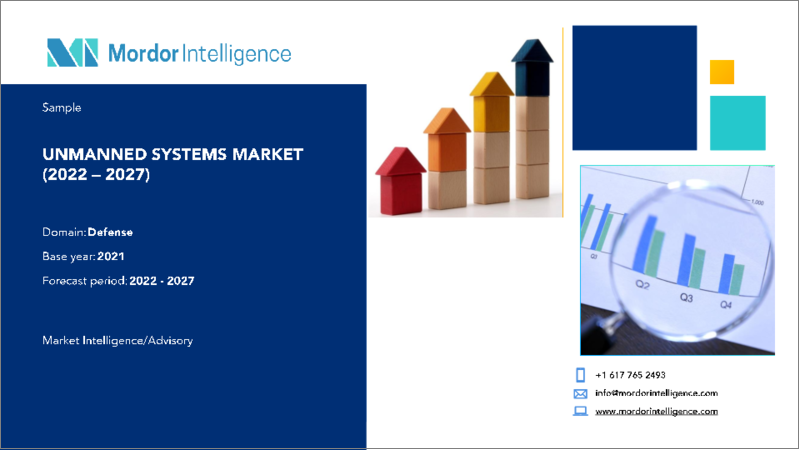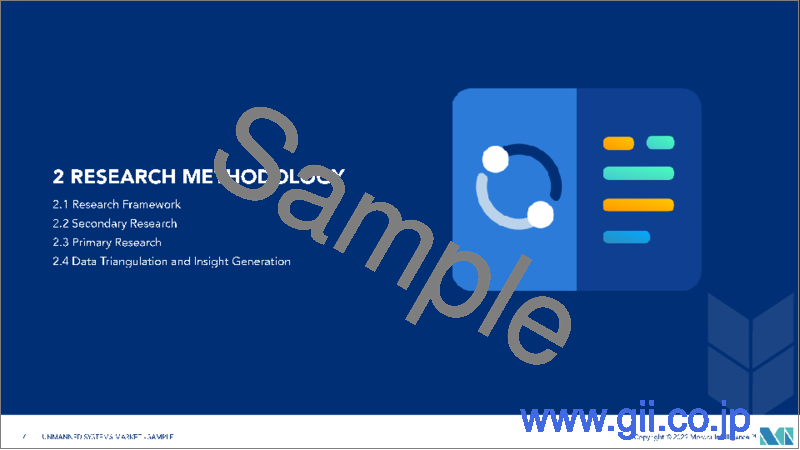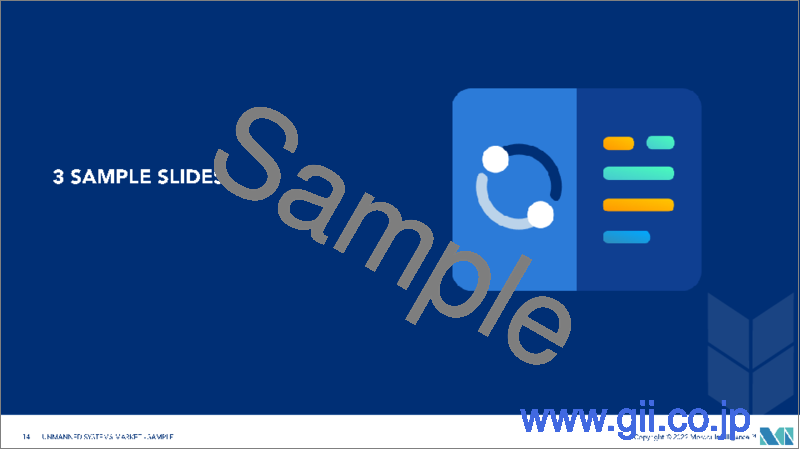|
|
市場調査レポート
商品コード
1137995
無人機システム市場- 成長、動向、予測(2022年~2027年)Unmanned Systems Market - Growth, Trends, and Forecasts (2022 - 2027) |
||||||
|
● お客様のご希望に応じて、既存データの加工や未掲載情報(例:国別セグメント)の追加などの対応が可能です。 詳細はお問い合わせください。 |
|||||||
| 無人機システム市場- 成長、動向、予測(2022年~2027年) |
|
出版日: 2022年10月13日
発行: Mordor Intelligence
ページ情報: 英文 110 Pages
納期: 2~3営業日
|
- 全表示
- 概要
- 目次
無人機システム市場は、予測期間中に12%のCAGRで推移すると予想されます。
COVID-19のパンデミックは、市場の成長と機会にややマイナスの影響を及ぼしました。世界の防衛費の増加と防衛力強化への注力は、市場の成長を促進します。防衛分野は、近隣諸国間の戦況や国境を越えた紛争の増加により、各国が高度な無人機システムの調達に継続的に投資したため、パンデミックの間、安定した成長を示しました。米国国防総省(DoD)は、無人航空機(UAV)の調達のために、2020年に13億米ドルを投資しました。これらの要因から、地上、海軍、航空などあらゆるプラットフォームでの無人機システムの需要が高まっています。
戦闘や情報・監視・偵察(ISR)任務における無人機システムの使用増加が、市場の成長を後押ししています。防衛軍は、有人システムよりも無人機システムの方が兵士の死傷リスクを軽減し、戦闘活動中の精度を高めることができるため、その開発・調達に大きな投資を行っています。消防や農業における無人地上車両、海底探査や海洋調査における無人海上車両、災害救助やレクリエーション用途、写真・ビデオ撮影におけるUAVなど、商業分野での無人機システムの利用拡大が、予測期間中の市場成長を押し上げると予想されます。
UAV、UGV、USVに人工知能やIoTなどの次世代技術が導入されることで、今後数年間は自律システムの高い需要が生まれるでしょう。自律システムに対する投資の増加により、様々な企業が先進的な自律走行車の開発に取り組んでいます。
主な市場動向
無人海上システム部門が予測期間中に最も高い成長を遂げる
市場の無人海上システム部門は、予測期間中に最も高いCAGRで推移すると予想されます。現在、無人海上システムの使用は、深海探査のための様々な研究機関によって高く評価されています。国際エネルギー機関(IEA)によると、天然ガスの需要は2025年まで1.5%で成長すると予想されています。石油・ガスは、2050年には世界の一次エネルギー供給の約44%を占める重要な役割を担うことになります。石油・ガス会社は、海底地図の作成に無人潜水機を高く評価しています。
2021年10月、ニュージーランドのBoxfish Research社は、ノルウェーのパートナーTransmark Subsea社とともに、新しいクラスの海中ビークル「ARV-I」を発売しました。このビークルはユーザーに操作の柔軟性を提供し、完全自律の手動制御または自己操縦のための設定が可能です。さらに2022年7月、Leidosは米国海軍と、魚雷発射管によるデータ収集作業や表面発射型機雷対策用の中型無人海中ビークルを開発する3億5850万米ドル相当の契約に調印しました。
教育機関での自律型地上・海中ビークルの利用が、この成長を支えています。さらに、軍事分野では、米国、中国、ロシアが無人海上システムの増強に取り組んでいます。米国海軍は、大型無人水上機(LUSV)、中型無人水上機(MUSV)、超大型無人海中機(XLUUV)の3種類の大型無人機(UV)の開発・調達を計画しており、2023年度の米国海軍の予算案では、大型無人水上機(LUSV)、中型無人水上機、特大無人海中機(XLUUV)の3種類のUVの開発・調達を予定しています。米国海軍は、これらの無人機に対する資金として5億4930万米ドル、XLUUVやその他のUUVのコア技術に対する追加資金として6070万米ドルの2023年度予算要求を提案しました。
予測期間中、アジア太平洋地域が最も高い需要を生み出すと予想される
アジア太平洋地域は、予測期間中、無人機システムに対する需要が最も高くなると予測されています。この成長は、この地域の国々による防衛費の増加と、商業部門での無人機システムの使用に関する規制の変更に起因しています。インド、日本、インドネシアなどの国では現在、小包や貨物の輸送に無人航空機を利用する取り組みが行われています。国境を越えた紛争の増加、テロの拡大、近隣諸国の政情不安などを背景に、中国、インド、オーストラリアなどから次世代無人機システムの調達が増加していることが、地域全体の市場成長を後押ししています。
同様に、韓国、日本、中国などでは、重い荷物や現場機器の移動、負傷者の避難など、さまざまな手作業を行う軍隊を支援するためにUGVの開発が進められています。2022年9月には、日本のドローンファンド(DF)がドローン大手のAerodyne India Groupと製造設備への投資で提携し、同社はインドのUAVエコシステムに4000万米ドルを投資する予定です。そのほか、2022年4月には、インドの国防研究開発機構(DRDO)が戦車「Arjun Mk.1A」をベースにした無人地上戦闘車の開発を開始しました。
さらに2022年8月には、中国東部の研究チームが、空中を高速で飛行できる潜水艦ドローンの試作機を開発しました。2022年3月、ボーイングのInsitu Pacific Pty Ltdは、ブリスベンで開発された24機の新しい無人航空監視システムをオーストラリア陸軍に供給する予定です。その費用は6億5,000万米ドルです。
競合情勢
無人機市場は非常に細分化されており、UAV、UGV、USVなど、さまざまな無人機プラットフォームを提供するサプライヤーが多数存在します。無人機市場の主なプレイヤーは、BAE Systems plc、Lockheed Martin Corporation、Saab AB、The Boeing Company、およびNorthrop Grumman Corporationです。BAE Systems、Saab AB、ECA Groupなど、あらゆるタイプの無人機システムを提供するプレイヤーも少数ながら存在し、これらは企業が資本力を発揮して地理的プレゼンスを拡大し、キャッシュフローの多様化にも役立っています。製品の革新は、企業が防衛や商業部門から新たな契約を獲得するための主要な要因です。これに加えて、現地企業と大手企業のM&Aにより、製品ポートフォリオと市場での存在感を拡大することが可能になっています。
2021年2月、防衛先端技術集団EDGEは、新シリーズの無人地上車両SCORPIO-Bを発表しました。遠隔武器システム、パンチルトズーム(PTZ)カメラと情報・監視・偵察(ISR)センサー、ツイン40mmグレネードランチャーを装備することができます。
その他の特典
- エクセル形式の市場予測(ME)シート
- アナリストによる3ヶ月間のサポート
目次
第1章 イントロダクション
- 調査の前提条件
- 調査範囲
第2章 調査手法
第3章 エグゼクティブサマリー
第4章 市場の力学
- 市場概要
- 市場促進要因
- 市場抑制要因
- ポーターのファイブフォース分析
- 買い手/消費者の交渉力
- 供給企業の交渉力
- 新規参入業者の脅威
- 代替品の脅威
- 競争企業間の敵対関係
第5章 市場セグメンテーション
- 種類
- 無人航空機(Unmanned Aerial Vehicle
- 小型UAV
- 中型UAV
- 大型UAV
- 無人地上機
- 車輪付き
- 追跡型
- 脚式
- ハイブリッド
- 無人海上システム
- 無人潜水機(UUV)
- 無人水上機(USV)
- 無人航空機(Unmanned Aerial Vehicle
- 応用分野
- 軍事・法執行
- 商業
- 地域
- 北米
- 概要
- 無人航空機
- 無人地上機
- 無人海上システム
- 欧州
- 概要
- 無人航空機
- 無人地上機
- 無人海上システム
- アジア太平洋地域
- 概要
- 無人航空機
- 無人地上機
- 無人海上システム
- ラテンアメリカ
- 概要
- 無人航空機
- 無人地上機
- 無人海上システム
- 中東・アフリカ地域
- 概要
- 無人航空機
- 陸上無人機
- 無人海上システム
- 北米
第6章 競合情勢
- ベンダーの市場シェア
- 企業プロファイル
- QinetiQ Group PLC
- Israel Aerospace Industries Ltd
- General Dynamics Corporation
- Rheinmetall AG
- Teledyne Technologies Incorporated
- ECA Group
- The Boeing Company
- Elbit Systems Ltd
- Lockheed Martin Corporation
- Saab AB
- BAE Systems PLC
- Northrop Grumman Corporation
- L3Harris Technologies Inc.
- DJI
- FLIR Systems Inc.
第7章 市場機会と今後の動向
The Unmanned Systems market is expected to witness a CAGR of 12% during the forecast period.
The COVID-19 pandemic had a slightly negative impact on market growth and opportunities. An increase in global defense expenditure and increased focus on strengthening defense forces drive the growth of the market. The defense sector witnessed steady growth during the pandemic as the countries continuously invested in the procurement of advanced unmanned systems due to growing warfare situations and cross-border conflicts among neighboring countries. The United States Department of Defense (DoD) invested USD 1.3 billion in 2020 for the procurement of unmanned aerial vehicles (UAVs). These factors lead to increasing demand for unmanned systems from all the platforms such as ground, naval, and airborne.
An increase in the use of unmanned systems for combat and intelligence, surveillance, and reconnaissance (ISR) missions drives the growth of the market. Defense forces are highly invested in developing and procuring unmanned systems over manned systems as it reduces the risks of soldier casualties and enhances accuracy during combat operations. The growing use of unmanned systems in the commercial sectors, like unmanned ground vehicles in firefighting and agriculture, unmanned sea vehicles for underwater sea exploration and marine research, and UAVs for disaster relief, recreational uses, and photo and videography is expected to boost the growth of the market during the forecast period.
The introduction of next-generation technologies, like artificial intelligence and IoT in the UAVs, UGVs, and USVs will create higher demand for autonomous systems in coming years. Rising investments in autonomous systems are bringing various companies together to develop advanced autonomous vehicles.
Key Market Trends
The Unmanned Sea Systems Segment to Experience the Highest Growth During the Forecast Period
The unmanned sea systems segment of the market is anticipated to witness the highest CAGR during the forecast period. Currently, the use of unmanned sea systems is higher by various research organizations for deep-sea exploration. According to the International Energy Agency, the demand for natural gas is anticipated to grow at 1.5% up to 2025. Oil & gas will play vital roles in the future and account for around 44% of the world's primary energy supply in 2050. The oil & gas companies highly adopted unmanned underwater vehicles for making seafloor maps.
In October 2021, Boxfish Research, a New Zealand-based company with its Norwegian partner Transmark Subsea launched the ARV-I, a new class of underwater sea vehicles. The vehicles offer users operational flexibility and are configurable for fully autonomous manual control or self-piloting. Furthermore, in July 2022, Leidos signed a contract worth USD 358.5 million contract with the U.S. Navy to develop a medium-size unmanned undersea vehicle for torpedo tube-launched data collection operations and surface-launched mine countermeasures.
The use of autonomous surface and underwater vehicles by educational institutes is supporting this growth. Moreover, in the military sector, the United States, China, and Russia are working toward increasing their fleet of unmanned sea systems. The United States Navy is planning to develop and procure three types of large unmanned vehicles (UVs) that includes Large Unmanned Surface Vehicles (LUSVs), Medium Unmanned Surface Vehicles (MUSVs), and Extra-Large Unmanned Undersea Vehicles (XLUUVs). The United States Navy proposed FY2023 budget requests of USD 549.3 million in funding for these unmanned vehicles and USD 60.7 million in additional for core technologies for XLUUV and other UUVs.
The Asia-Pacific Region is Expected to Generate the Highest Demand during the Forecast Period
The Asia-Pacific region is projected to generate the highest demand for unmanned systems during the forecast period. This growth is attributed due to a rise in defense expenditure by the countries in this region, along with the changing regulations for the use of unmanned systems in the commercial sector. Countries such as India, Japan, and Indonesia, are currently working on the use of unmanned aerial vehicles for the transportation of parcels and cargo. Growing procurement of next-generation unmanned systems from China, India, Australia, and others due to rising cross-border conflicts, growing terrorism, and political unrest among neighboring countries drive the growth of the market across the region.
Similarly, the development of UGVs is being carried out in South Korea, Japan, and China, among others, for assisting their armed forces with a range of manual handling tasks, like moving heavy loads and field equipment, and casualty evacuations. In September 2022, Japan-based Drone Fund (DF) tied up with drone major Aerodyne India Group to invest in manufacturing facilities, and the company is planning to invest USD 40 million in the UAV ecosystem in India. In addition to that, in April 2022, India's Defense Research and Development Organization (DRDO) started developing an unmanned ground combat vehicle based on the Arjun Mk.1A tank.
Furthermore, in August 2022, the research team from eastern China developed a submarine drone prototype that can fly in the air at high speed. In March 2022, Boeing's Insitu Pacific Pty Ltd will supply twenty-four new unmanned aerial surveillance systems, developed in Brisbane, to the Australian Army. The cost of the project was USD 650 million.
Competitive Landscape
The market for unmanned systems is highly fragmented, with a large number ofsuppliers who provide different unmanned platforms, like UAVs, UGVs, and USVs. The major players in the unmanned systems market are BAE Systems plc, Lockheed Martin Corporation, Saab AB, The Boeing Company, and Northrop Grumman Corporation. There are a few players, like BAE Systems, Saab AB, and ECA Group, among others who provide all types of unmanned systems, which help the companies to capitalize and expand their geographic presence, as well as diversify their cash flows. Product innovation is the primary factor that aids companies in getting new contracts from the defense, as well as commercial sectors. In addition to this, the mergers and acquisitions of the local companies with the major companies are allowing them to expand their product portfolio and market presence.
In February 2021, the advanced defense advanced technology group, EDGE, unveiled a new series of unmanned ground vehicles SCORPIO-B. It can be equipped with remote weapon systems, pan-tilt-zoom (PTZ) cameras and intelligence, surveillance, and reconnaissance (ISR) sensors, and twin 40mm grenade launchers.
Additional Benefits:
- The market estimate (ME) sheet in Excel format
- 3 months of analyst support
TABLE OF CONTENTS
1 INTRODUCTION
- 1.1 Study Assumptions
- 1.2 Scope of the Study
2 RESEARCH METHODOLOGY
3 EXECUTIVE SUMMARY
4 MARKET DYNAMICS
- 4.1 Market Overview
- 4.2 Market Drivers
- 4.3 Market Restraints
- 4.4 Porter's Five Forces Analysis
- 4.4.1 Bargaining Power of Buyers/Consumers
- 4.4.2 Bargaining Power of Suppliers
- 4.4.3 Threat of New Entrants
- 4.4.4 Threat of Substitute Products
- 4.4.5 Intensity of Competitive Rivalry
5 MARKET SEGMENTATION
- 5.1 Type
- 5.1.1 Unmanned Aerial Vehicles
- 5.1.1.1 Small UAVs
- 5.1.1.2 Medium UAVs
- 5.1.1.3 Large UAVs
- 5.1.2 Unmanned Ground Vehicles
- 5.1.2.1 Wheeled
- 5.1.2.2 Tracked
- 5.1.2.3 Legged
- 5.1.2.4 Hybrid
- 5.1.3 Unmanned Sea Systems
- 5.1.3.1 Unmanned Underwater Vehicles (UUVs)
- 5.1.3.2 Unmanned Surface Vehicles (USVs)
- 5.1.1 Unmanned Aerial Vehicles
- 5.2 Application
- 5.2.1 Military and Law Enforcement
- 5.2.2 Commercial
- 5.3 Geography
- 5.3.1 North America
- 5.3.1.1 Overview
- 5.3.1.2 Unmanned Aerial Vehicles
- 5.3.1.3 Unmanned Ground Vehicles
- 5.3.1.4 Unmanned Sea Systems
- 5.3.2 Europe
- 5.3.2.1 Overview
- 5.3.2.2 Unmanned Aerial Vehicles
- 5.3.2.3 Unmanned Ground Vehicles
- 5.3.2.4 Unmanned Sea Systemss
- 5.3.3 Asia-Pacific
- 5.3.3.1 Overview
- 5.3.3.2 Unmanned Aerial Vehicles
- 5.3.3.3 Unmanned Ground Vehicles
- 5.3.3.4 Unmanned Sea Systems
- 5.3.4 Latin America
- 5.3.4.1 Overview
- 5.3.4.2 Unmanned Aerial Vehicles
- 5.3.4.3 Unmanned Ground Vehicles
- 5.3.4.4 Unmanned Sea Systems
- 5.3.5 Middle-East and Africa
- 5.3.5.1 Overview
- 5.3.5.2 Unmanned Aerial Vehicles
- 5.3.5.3 Unmanned Ground Vehicles
- 5.3.5.4 Unmanned Sea Systems
- 5.3.1 North America
6 COMPETITIVE LANDSCAPE
- 6.1 Vendor Market Share
- 6.2 Company Profiles
- 6.2.1 QinetiQ Group PLC
- 6.2.2 Israel Aerospace Industries Ltd
- 6.2.3 General Dynamics Corporation
- 6.2.4 Rheinmetall AG
- 6.2.5 Teledyne Technologies Incorporated
- 6.2.6 ECA Group
- 6.2.7 The Boeing Company
- 6.2.8 Elbit Systems Ltd
- 6.2.9 Lockheed Martin Corporation
- 6.2.10 Saab AB
- 6.2.11 BAE Systems PLC
- 6.2.12 Northrop Grumman Corporation
- 6.2.13 L3Harris Technologies Inc.
- 6.2.14 DJI
- 6.2.15 FLIR Systems Inc.




